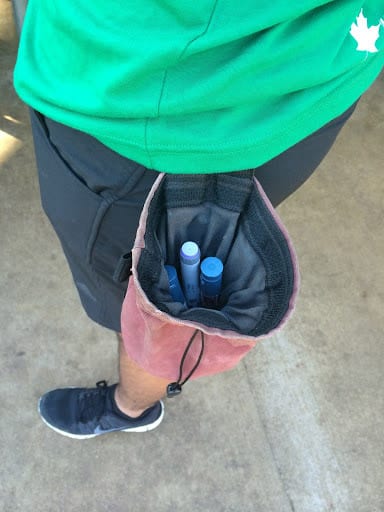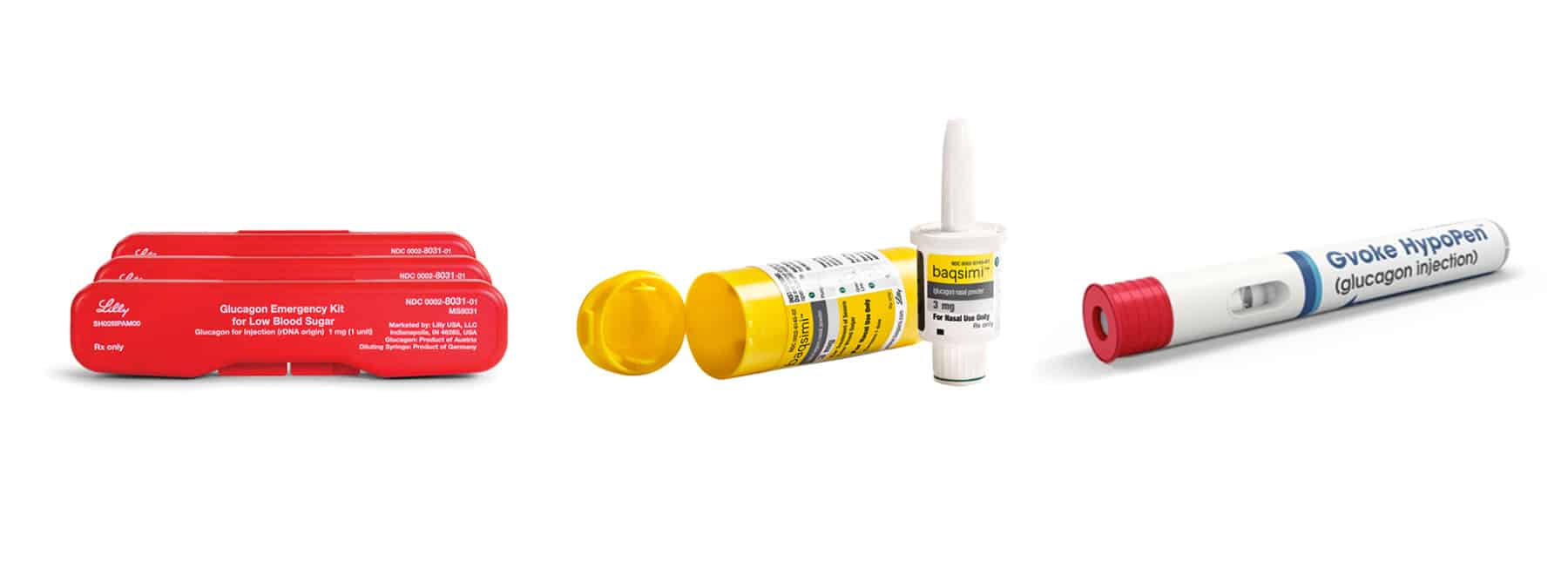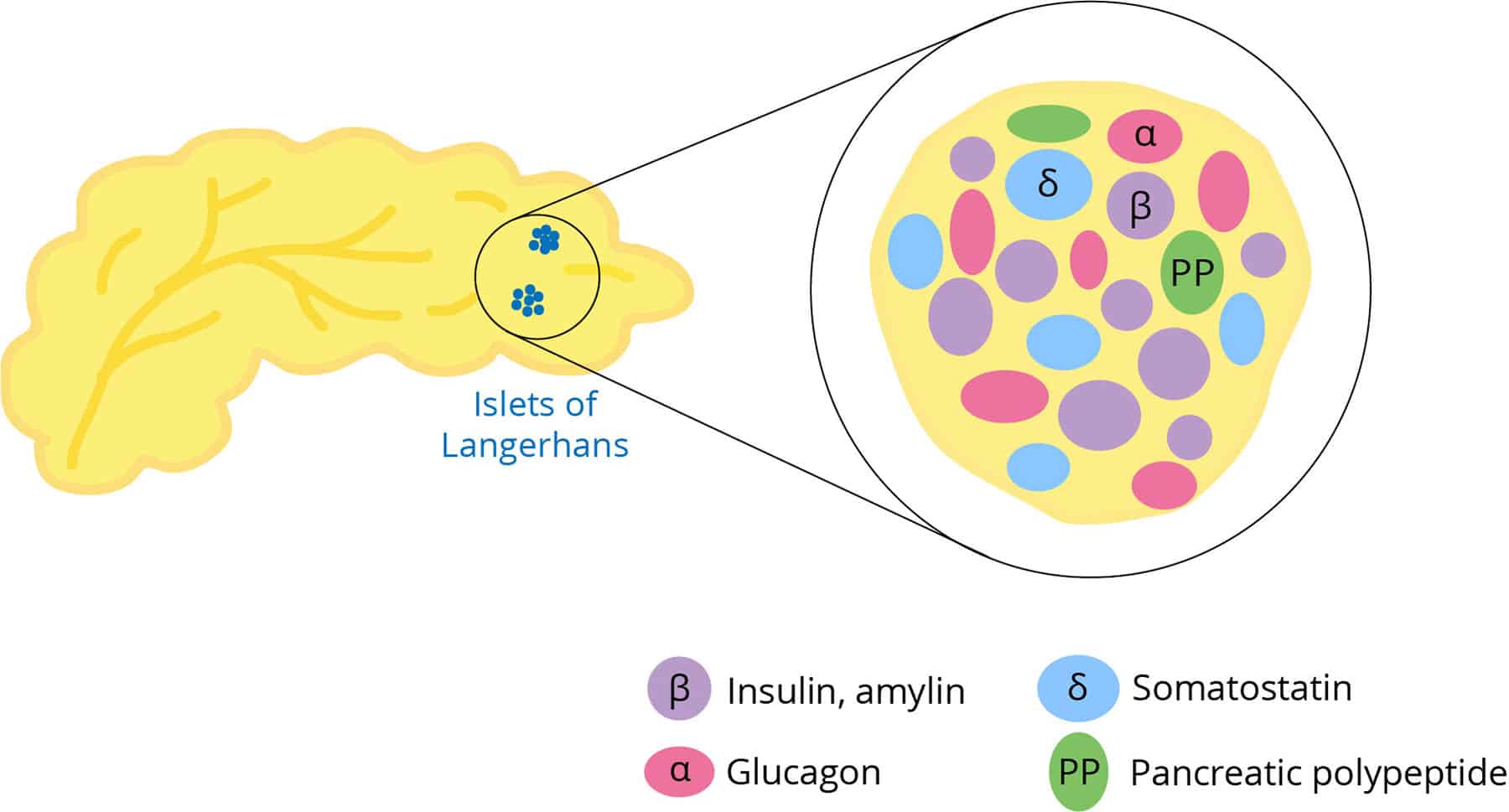This blog post on the many hormones the pancreas produces is part of the insulin centennial series celebrating the 100th anniversary of the discovery of insulin.

One of the most important hormones the pancreas produces is—you guessed it—insulin! But the pancreas does a lot! What other hormones does it produce?
Glucagon
You’re probably familiar with glucagon as an emergency remedy for extremely low blood sugar. While insulin is produced by beta cells in the islets of Langerhans, glucagon is produced by alpha cells [1]. You can think of glucagon as the opposite of insulin—it raises blood sugar instead of lowering it.
The pancreas releases glucagon when blood glucose levels are low, triggering the liver to begin glycogenolysis which converts glycogen (glucose in storage form) to glucose [1]. Glucagon also stimulates gluconeogenesis, or the production of glucose from amino acids and glycerol [1].

Available types of glucagon
Source: “Glucagon”, Beyond Type 1, https://beyondtype1.org/glucagon/
Somatostatin
Somatostatin is produced by many tissues in the body, but in the pancreas, it is produced by the delta cells of the islets of Langerhans. It inhibits the activity of gastrointestinal and pancreatic hormones including both insulin and glucagon. The relative concentrations of somatostatin, insulin, and glucagon together regulate the overall rate of glucose storage and metabolism [2].
Pancreatic Polypeptide
Pancreatic polypeptide is secreted by the PP cells of the islets of Langerhans in the pancreas [3]. Eating, exercising, and fasting can all stimulate its secretion. After a meal, it is rapidly released and remains at elevated levels for 4 to 6 hours [4]. Pancreatic polypeptide inhibits secretion of pancreatic digestive enzymes [3].
Amylin
Amylin is co-secreted with insulin from beta cells in the islets of Langerhans to maintain glucose levels. It reduces the secretion of glucagon. Additionally, it regulates blood pressure [5].

Cell types and hormones released in the pancreas
Gastrin
Gastrin is produced by G-cells primarily in the stomach and upper small intestine. After a meal, gastrin stimulates the stomach to release gastric acid which promotes the break-down of proteins, absorption of vitamins, and disinfection of bacteria [6]. Gastrin is also produced in the pancreas where it acts on acinar cells that are responsible for the synthesis, storage, and secretion of pancreatic digestive enzymes [7].
Ghrelin
Ghrelin is produced primarily in the stomach, but also in the pancreas, small intestine, and brain. It has been nicknamed the “hunger hormone” because it stimulates appetite and promotes fat storage [6]. It also regulates glucose levels by inhibiting insulin secretion and regulating gluconeogenesis and glycogenolysis. Additional functions include regulating energy expenditure, reducing sympathetic nerve activity, preventing muscle atrophy, and regulating bone formation [8].
Neuronostatin
Neuronostatin is a recently discovered hormone also encoded by the somatostatin gene [9]. It has been found to inhibit glucose-stimulated insulin secretion and increase glucagon secretion [9, 10]. Some scientists believe neuronostatin has the potential to be used to prevent hypoglycemia in the future [10].
References
- The Editors of Encyclopaedia Britannica. “Glucagon.” Encyclopædia Britannica, Encyclopædia Britannica, Inc., 12 May 2014, www.britannica.com/science/glucagon.
- Utiger, Robert D. “Somatostatin.” Encyclopædia Britannica, Encyclopædia Britannica, Inc., 7 Feb. 2011, www.britannica.com/science/somatostatin.
- The Editors of Encyclopaedia Britannica. “Pancreatic Polypeptide.” Encyclopædia Britannica, Encyclopædia Britannica, Inc., 15 Feb. 2019, www.britannica.com/science/pancreatic-polypeptide.
- Williams, John A. “Pancreatic Polypeptide.” Pancreapedia, Michigan Publishing, University of Michigan Library, www.pancreapedia.org/molecules/pancreatic-polypeptide.
- Zhang, Xiao-Xi et al. “Neuroendocrine hormone amylin in diabetes.” World journal of diabetes vol. 7,9 (2016): 189-97. doi:10.4239/wjd.v7.i9.189
- “Gastrin.” You and Your Hormones, The Society for Endocrinology, www.yourhormones.info/hormones/gastrin/.
- Prosapio JG, Sankar P, Jialal I. Physiology, Gastrin. [Updated 2020 Apr 25]. In: StatPearls [Internet]. Treasure Island (FL): StatPearls Publishing; 2020 Jan-. Available from: https://www.ncbi.nlm.nih.gov/books/NBK534822/
- Pradhan, Geetali et al. “Ghrelin: much more than a hunger hormone.” Current opinion in clinical nutrition and metabolic care vol. 16,6 (2013): 619-24. doi:10.1097/MCO.0b013e328365b9be
- Salvatori, Alison S et al. “Neuronostatin inhibits glucose-stimulated insulin secretion via direct action on the pancreatic α-cell.” American journal of physiology. Endocrinology and metabolism vol. 306,11 (2014): E1257-63. doi:10.1152/ajpendo.00599.2013
- Experimental Biology. “New hope for preventing dangerous diabetes complication: Neuronostatin offers potential therapeutic target for treating and avoiding low blood sugar.” ScienceDaily. ScienceDaily, 7 April 2019. <www.sciencedaily.com/releases/2019/04/190407144147.htm>.





